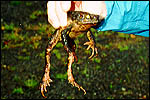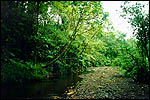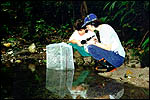By Mary Losure
June 2, 1998
|
|
RealAudio 2.0 14.4 |
Other reports from the series:
Multiple Threats to Amphibian Populations
Frog Deformities May Warn of Human Risk

![]() Frogs and toads are disappearing all over the world. No one knows all the
reasons why.
Frogs and toads are disappearing all over the world. No one knows all the
reasons why.
The destruction of wetlands and other places where amphibians live is one of the major causes... but frogs and toads have also been dying out in protected sites far from any human disturbance.
Worldwide environmental problems - airborne contaminants, global climate change, or higher-than-normal ultraviolet light from the earth's thinning ozone
layer - have all been linked to frog disappearances, but now there's hard
evidence of another possible culprit.

|
| The stream at Fortuna. |
THE STREAM AT FORTUNA, IN THE MOUNTAINS OF WESTERN PANAMA, flows through tall trees draped with moss and hanging vines, with gardens of orchids in their top branches. Jaguars live here, and brilliant blue butterflies the size of small birds. Pink flowers drop from the treetops and float in the clear pools, but to amphibian biologist Karen Lips the scene is strangely empty.
Lips: We should be listening right now to hundreds and hundreds of colesthesus, these little, tiny, brown frogs with racing stripes that chatter away like tiny birds in the forest. There should be harlequin frogs bounding around on the shorelines, that we could pick up and they'd make little calls. Even though it looks wonderful, it looks like beautiful, upland old growth cloud forest, something's the matter.
To her trained biologist's eye, it's like a crime scene after police have carried away the bodies. Last year she found dead and dying frogs here, day after day - many different species, all looking as though they had been struck dead at once.
Lips: Some of them looked really lifelike, they were still sort of sitting there as if they had come out the night before to do their mating ritual, and just sort of fallen asleep. Or frozen in place, because you'd go up to them and grab them, and they'd be dead or dying.

|
| Karen Lips and the reporter search for specimens. |
Frogs are food for so many predators that a biologist can spend a lifetime in the field and see only one or two dead frogs. So many, all at once, was an
unprecedented find.
Lips: To come out, day after day after day, and find more and more dead frogs of so many species, and to have no obvious trauma to their bodies - I mean, the only thing we could think of was that it was probably some sort of disease.
At night she walks the Panamanian streams with a miner's light, documenting the few frogs species that are left.
Lips: See how quiet it is? You can only hear a couple crickets chirping away and every so often you can hear an eleutherodactylus, what we call a tink frog, it goes "Tink! Tink!" in the background there.
In the darkness, the light plays along the rocks and pools and searches the
leaves of overhanging plants. The night life of the rain forest is suddenly
illuminated - a giant insect with waving antennae, a snake swallowing a lizard
- but there are no frogs. Then she hears a distinctive call.
SFX of frog call: Peep peep!
Lips: Did you hear that high-pitched, double-note call? [imitates] Peep peep! Lets see if he's here, and if we turn off the lights, he'll probably start calling again.
What she hears is a glass frog. They get that name from their skin, so
transparent you can see through it - all the way to their green bones. Lips used to find them everywhere, shimmering green, each frog chirping from the same leaf night after night. We listen for a long time to all the night voices, but the Glass Frog does not call again. Lips gets out her notebook and writes down the spot and the hour of the lone call, her sole entry so far this night.
Lips: We had two the other night. This same particular spot we saw a pair of Glass Frogs; they were mating. Normally we would catch them and try to look for this disease organism or whatever, but since it was a male and a female, and they may be the last hope for this particular stream, we decided to let them lay their eggs in peace, so we just wrote down that they were here, what time it was, and moved on.
The sudden, mysterious disappearances Lips is documenting at Fortuna in Panama have happened before, in other mountain ranges around the world. Certain species of frogs have utterly vanished from the high elevations in the western United States, South America, and Australia. Scientists suspected disease, but they were never able to prove it. Now for the first time, they've found a culprit, a disease organism they believe caused the deaths in Panama.
George Rabb: It's a very strange, fungus-like creature, fungus-like organism... and what it does is simply so pervade the epidermis, the outer level of the skin, that the frogs can't respire - they can't exchange oxygen or water through the skin.
George Rabb is director of the Brookfield Zoo in Chicago, and one of the leaders in the worldwide effort to solve the decling frog mystery. He
says Australian scientists have found the same odd fungus in dead frogs
collected in mountain rainforests in Australia.
The declines in Panama and elsewhere appear to be moving in a wave through the mountains. But if a wave-like pattern of disease is indeed responsible for the mysterious deaths of frogs in pristine places around the world, Rabb says the next question is "why?"
Rabb: These things have been around for hundreds of millions of years, both the frogs and this strange fungus-like organism. What has changed in the environment that suddenly makes the frogs - which are sort of notable survivors on the planet - what has changed out there in the environment that suddenly these creatures are susceptible?
Many researchers suspect frogs are becoming stressed by worldwide environmental problems like pollution, global warming, or higher-than-normal levels of ultraviolet light from the earth's thinning ozone layer. It's possible that's why they may be succumbing to diseases now.
This summer, Karen Lips and other researchers will return to Panama. They'll
take air and water samples and test for pesticides, heavy metals, and other
contaminants that could be carried by the winds and rain. They'll study the site at Fortuna where Lips first found the dead frogs, and another mountain
rainforest site called El Cope. If a disease wave is moving eastward
through the mountains, it will hit El Cope in a couple of years.

|
| A valley in El Cope. |
For now, the frogs at El Cope seem secure in their mountain sanctuary.
The little brown frogs with the racing stripes, the ones that have vanished
from Fortuna, sing here all day long, the white vocal sacs on their tiny throats bulging in and out, like lights blinking. You can walk up this stream and find hundreds of species of frogs, including a beautiful rare one called the golden frog - not to be confused with the now extinct golden toad. Golden frogs hear through their skins, and communicate with each other by waving their front feet.
These frogs, of course, have no idea what's in store for them. But for a human observer, it's hard to look at this stream, knowing that in a few years it, too, may be empty.
Funding for our series on vanishing frogs was provided by the listeners of Minnesota Public Radio, and by a grant from the Society of Environmental Journalists. Special thanks to researcher Karen Lips and field assistant Liese Greensfelder for their help with the Panama segment. Photographs by Liese Greensfelder.
